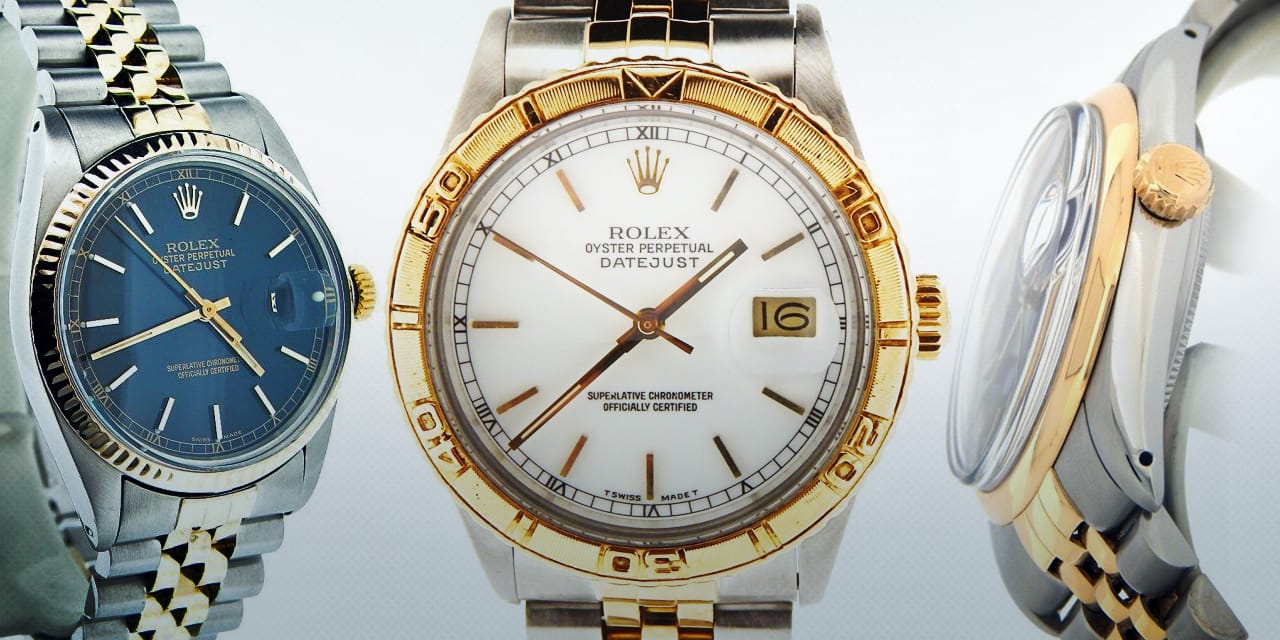Two Tone Rolex Datejust Compare: 1600, 1601, 1625 vs. 16003, 16013, 16253
One of the most iconic watches you could ever own, the two tone Rolex Datejust has been around for more than seven decades. During that time, Rolex has continuously improved upon the two tone Rolex Datejust while maintaining its signature style. To highlight just what those differences and enhancements are, today we compare the four-digit two tone Datejust references to the five-digit two tone Datejust references that succeeded them.
The Mutual Design Traits
Prior to highlighting the differences, it’s essential to point out what the shared design traits of all two tone Datejust models are, irrespective of the production period. This is after all how Rolex established the unmistakable design codes of the watch.
First off, all of the two tone Datejust watches that we are discussing here have 36mm Oyster cases. Of course, there are built to be water resistant to 100 meters. Remember, when the Oyster Perpetual Datejust made its debut in 1945, it was the first waterproof automatic chronometer-certified wristwatch to display the date on the dial. Second, one of the key characteristics of the Datejust is the Cyclops date magnification lens protruding from the exterior of the crystal on top of the dial. Third, the two tone style is the combination of yellow gold and stainless steel on the same watch. Rolex refers to the two tone style as Rolesor. Finally, the “Perpetual” in “Oyster Perpetual” is to signify the self-winding mechanical movements at the heart the Datejust.
Design: Two Tone Rolex Datejust 1600, 1601, 1625 vs. 16003, 16013, 16253
The two tone Rolex Datejust ref. 1600 and ref. 16003 have yellow gold smooth (aka domed) bezels, the ref. 1601 and ref. 16013 have yellow gold fluted bezels, and the ref. 1625 and ref. 16253 have yellow gold engine-turned rotating Turn-O-Graph bezels.
The Four Digit References
Rolex manufactured the two tone Datejust ref. 1600, ref. 1601, and ref. 1625 watches beginning in the early 1960s until the late 1970s/early 1980s. As vintage models, these four-digit two tone Datejust watches include acrylic crystals, cases with drilled lug holes, and tritium on the dial for luminescence. While these particular two tone Datejust watches came outfitted with either Oyster or Jubilee bracelets with hollow links and end pieces, the lug holes allow for easy strap switching. Depending on the exact time of manufacturing, the links on the two tone bracelets can be riveted, folded, oval, or D-Link.
The Five Digit References
At the end of the 1970s, Rolex slowly began replacing the four-digit two tone Datejust models with new five-digit references—the ref. 16003, 16013, and 16253 models. Although the new two tone Datejust models were already in production, there was some overlap between both generations. Rolex had to sell out the older models before focusing solely on the newer versions.
The two tone Datejust ref. 16003, ref. 16013, and ref. 16253 retained the acrylic crystals, tritium, and lug holes, along with the hollow links and end pieces on the Oyster and Jubilee bracelets and the “D-Link” style of the Jubilee band.
Whilst the exterior design was similar across both generations of the two tone Datejust models, the major modification was found inside the case.
Movement: Two Tone Rolex Datejust 1600, 1601, 1625 vs. 16003, 16013, 16253
If you remove the casebacks from the two tone Rolex Datejust ref. 1600, ref. 1601, and ref. 1625 models, you will either find Caliber 1560 or Caliber 1570. These are non-quickset automatic mechanical movements, which means that the setting of the date is dependent on the center hour and minute hands. Therefore, the hands must pass midnight for the numbers to change in the window at 3 o’clock.
The five-digit two tone Datejust 16003, 16013, and 16253 however, run on Caliber 3035. This time, the watches include the handy quickset date function whereby the date window is set independently from the center timekeeping hands.
In short, when comparing the ref. 1600, ref. 1601, and ref. 1625 two tone Datejust watches to the following ref. 16003, ref. 16013, and ref. 16253 Datejust watches, they are stylistically similar. Yet, because of the quickset feature of the Caliber 3035, they are mechanical different. So when settling on which two tone Datejust model to purchase, first decide if having a quickset Rolex is a deal breaker.
— Featured and Body Photo Credits: BeckerTime’s Archive.





